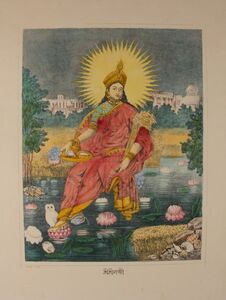Lakṣmī puja is the most neglected and taken for granted puja in the Hindu Almanac. Since she has just visited us accompanying her mother in the Sharadotsav and coming back on the fifth day after returning to Kailash, her position is somewhat eroded like the married daughter coming home too early.
Though she is worshipped daily in Bengali Hindu homes and commercial establishments as the goddess of wealth, she is given a step motherly treatment in the Sarbojinin puja. Her puja in the pandals are a leftover of funds from the worship of her mother Durga and she is not given the pride of place to either create a new pandal or given the due which she deserves. Much of this neglect is subterfuged under the guise of muted decor and puja as Lakṣmī is believed to be in favour of ‘calm and quiet’.But that is just a lame excuse and she knows it too.
In the traditional Bengali home she is worshiped on the day of Diwali when her alter image,the OLakṣmī is driven out and Lakṣmī is ushered in. It was left to the migrants of East Bengal to celebrate Lakṣmī puja on Kojagiri Purnima and hoist her in the exalted position. First,to worship her in the Lakṣmī 'sara'and then moving to the idol. Having lost everything in the partition of 1947 and making the other part of Bengal their home, they continued their reverence, praying to give them prosperity. She did not disappoint them and showered them with her blessings. Seeing this their Western brethren followed suit.
Lakṣmī is the Hindu Goddess of wealth, prosperity,both material and spiritual, fortune, and the embodiment of beauty. She is also worshipped as the consort of Vishnu. She is also known as Mahalakshmi ,is said to bring good luck and is believed to protect her devotees from all kinds of misery and money-related sorrows.
In Bengal, Lakṣmī is worshiped in autumn when the moon is full, the brightest night of the year. It is believed that she showers wealth on this night. She, along with her bahana, the great white owl, descends to Earth and takes away the darkness of poverty, stagnation, anger, and laziness from our lives. Her bahana owl represents royalties, penetrating sight and intelligence. It serves as her mount over which she has full control. Lakṣmī is also referred to as pranadayini , "giver of vital life-sustaining energy" who can turn a dull thing full of life.
One of the most compelling stories in Hindu mythology is that of the Churning of the Milky Ocean. It is the story of the gods versus the demons and their fight to gain immortality. It also tells of the rebirth of Lakṣmī . Devas,gods, and asuras,demons, were both mortal at one time, in Hinduism. Amrit, the divine nectar that grants immortality, could only be obtained by churning the Kshirsagar ,the Ocean of Milk. The devas and asuras both sought immortality and decided to churn the Kshirsagar.The samudra manthan commenced with the devas on one side and the asuras on the other. Vishnu incarnated as Kurma, the tortoise, and a mountain was placed on the tortoise as a churning pole. Vasuki, the great venom-spewing serpent, was wrapped around the mountain and used to churn the ocean. A host of divine celestial objects came up during the churning. Along with them emerged the goddess Lakṣmī, the daughter of Bhrigu and Khyaati.
The last to come up was the Amrita. The avatar of Kurma, the tortoise, ended with this. Vishnu then took up the form of a beautiful maiden to distract the asuras and gave immortality to the devas. She is 'shakti-roopa' of 'parabrahma' or 'adi dev narayan' in the 'Mahalakṣmī' story. OLakṣmī the goddess of misfortune, is Lakṣmī's elder sister, her alter image.
Lakṣmī is called Shree or Thirumagal because she is endowed with six auspicious and divine qualities, or Gunas, and also because she is the source of strength even to Vishnu. She is commonly portrayed as a beautiful woman, standing on a lotus flower. There is her ‘bahana’ the white owl which accompanies her.

